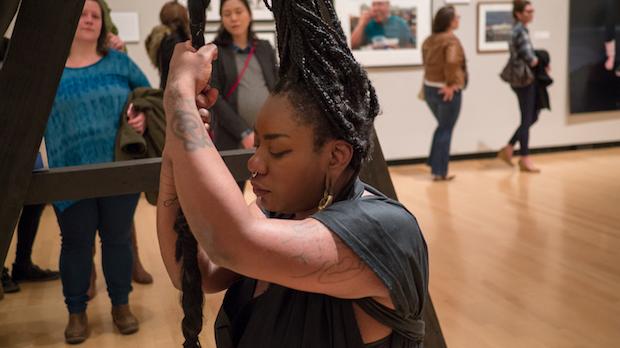Events
Trussed by Dana Mcknight
[OPENING] Artist and co-founder of Dreamland, Dana Mcknight, will present a thought-provoking, socio-political art exhibit at Box Gallery this Friday, January 6. The exhibit is described as “5 feet of braids attached as a pulley system to a black swing-set that resembles a gallows. It is a silent, physical conversation of how Black Women have been hammered since girlhood about their hair-length—a subtle indication of mixed heritage—of non-blackness…” A performance of the piece, which includes Mcknight physically attached to the installation apparatus, will take place at 9pm; the installation will be on display until January 31. This week we talked to Mcknight about her inspiration for the piece.
Tell me about the inspiration behind Trussed.
It was based off of the idea of generational trauma, and how black women for the most part have been conditioned both within their own families but also through society at large to straighten their hair, and how their hair is this massive, painful burden. But it makes a massive difference when it comes to survival in a fairly Euro-centric world. For example, your hair quality determines whether you’re passable as white or black, depending on your skin-tone, but you also have to keep it in a particular way to keep jobs. This is still the case today. They’ve just said that it’s okay for employers to discriminate against folks who have dreadlocks. Black people have to forcibly straighten their hair with chemicals or through other painful hair-straightening techniques—hot combs, relaxers. These are procedures that can take hours and leave lasting damage.
There is pressure from within the black communities or black families and from society at large to straighten your hair, but then is there also criticism when a black woman straightens her hair because it’s not natural and so on.
Right. I mean, the natural movement is pretty new. It started truly in the 1970s with the afro, which was a reclamation of black pride, but there is still a certain upkeep that you have to have an afro in, and it’s a lot of work to maintain that particular look. It’s systemic throughout the entirety of society, and it starts when you’re a little girl. The moment you start having hair as a child, it is being tamed in whatever way is necessary. I got my first straightening when I was five or six, and that’s pretty normal for a lot of black girls. There’s a loss of childhood associated with it too because unless you can keep to particular beauty standards, you will be shunned.
At that young age, what did you think when you had that first straightening? Was this something you asked for, was it something you were given or issued?
No, I had no choice in the matter. The majority of black girls don’t. It was traumatizing. I thought it was a way of life, it was a thing that was going to happen, it always happened.
Why have this conversation in terms of an installation?
For the installation I wanted it to be more performance-based. Performance art is pretty fantastic in that it actually pulls the audience in, more so than a film. I wanted people to actually see my own hair trauma. The main point of the piece outside of the whole allegory of black hair is that black women are suffering with this every fucking day and people have no idea.
When:
We're sorry, this event has already taken place!


COMMENTS